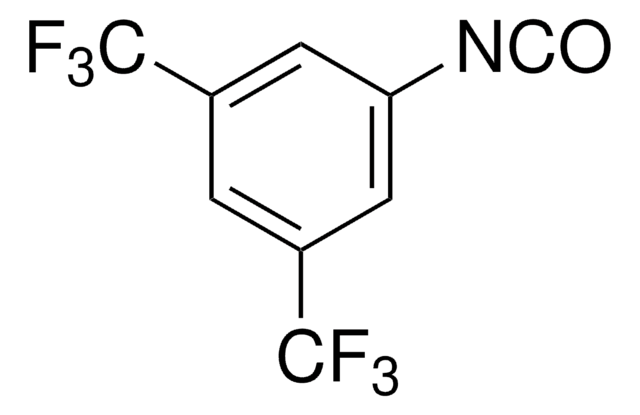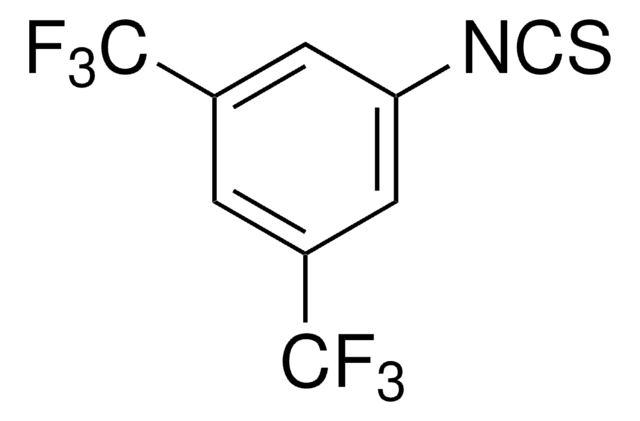803863
Schreiner′s Thiourea Catalyst
95%
Synonym(e):
N,N′−bis[3,5−bis(trifluoromethyl)phenyl]−Thiourea
About This Item
Empfohlene Produkte
Qualitätsniveau
Assay
95%
Form
powder or crystals
Eignung der Reaktion
reagent type: catalyst
Grünere Alternativprodukt-Eigenschaften
Catalysis
Learn more about the Principles of Green Chemistry.
sustainability
Greener Alternative Product
mp (Schmelzpunkt)
170 °C
Grünere Alternativprodukt-Kategorie
SMILES String
S=C(NC1=CC(C(F)(F)F)=CC(C(F)(F)F)=C1)NC2=CC(C(F)(F)F)=CC(C(F)(F)F)=C2
InChI
1S/C17H8F12N2S/c18-14(19,20)7-1-8(15(21,22)23)4-11(3-7)30-13(32)31-12-5-9(16(24,25)26)2-10(6-12)17(27,28)29/h1-6H,(H2,30,31,32)
InChIKey
RWXWQJYJWJNJNW-UHFFFAOYSA-N
Verwandte Kategorien
Allgemeine Beschreibung
Anwendung
Signalwort
Warning
H-Sätze
Gefahreneinstufungen
Eye Irrit. 2 - Skin Irrit. 2
Lagerklassenschlüssel
11 - Combustible Solids
WGK
WGK 3
Flammpunkt (°F)
Not applicable
Flammpunkt (°C)
Not applicable
Hier finden Sie alle aktuellen Versionen:
Analysenzertifikate (COA)
Die passende Version wird nicht angezeigt?
Wenn Sie eine bestimmte Version benötigen, können Sie anhand der Lot- oder Chargennummer nach einem spezifischen Zertifikat suchen.
Besitzen Sie dieses Produkt bereits?
In der Dokumentenbibliothek finden Sie die Dokumentation zu den Produkten, die Sie kürzlich erworben haben.
Kunden haben sich ebenfalls angesehen
Verwandter Inhalt
Boronate ureas benefit from internal Lewis acid coordination of the urea cabonyl oxygen and the strategically placed boron. As a result of this structural feature, boronate ureas can be rendered more acidic than conventional urea hydrogen bond donor catalysts.
Unser Team von Wissenschaftlern verfügt über Erfahrung in allen Forschungsbereichen einschließlich Life Science, Materialwissenschaften, chemischer Synthese, Chromatographie, Analytik und vielen mehr..
Setzen Sie sich mit dem technischen Dienst in Verbindung.![1,3-Bis[3,5-bis(trifluoromethyl)phenyl]thiourea](/deepweb/assets/sigmaaldrich/product/structures/191/427/0218c99c-65b9-4963-938c-c47a5790dfc5/640/0218c99c-65b9-4963-938c-c47a5790dfc5.png)

![1-[3,5-bis(trifluoromethyl)phenyl]-3-[(1R,2R)-(-)-2-(dimethylamino)cyclohexyl]thiourea AldrichCPR](/deepweb/assets/sigmaaldrich/product/structures/236/021/d944889d-2233-4700-9f2c-caa3652d0124/640/d944889d-2233-4700-9f2c-caa3652d0124.png)
![1-[3,5-Bis(trifluoromethyl)phenyl]-3-[(1R,2R)-(−)-2-(dimethylamino)cyclohexyl]thiourea](/deepweb/assets/sigmaaldrich/product/structures/384/772/d336462c-f438-446d-be0c-4064705213cc/640/d336462c-f438-446d-be0c-4064705213cc.png)



![(S)-2-[[3,5-Bis(trifluormethyl)phenyl]thioureido]-N-benzyl-N,3,3-Trimethylbutanamid 97%](/deepweb/assets/sigmaaldrich/product/structures/373/888/118b46f2-6c2e-4a87-8266-c4dbcd5db51f/640/118b46f2-6c2e-4a87-8266-c4dbcd5db51f.png)
![N-[3,5-Bis-(trifluormethyl)-phenyl]-N′-[(8a,9S)-6′-methoxy-cinchonanyl]-thioharnstoff 90%](/deepweb/assets/sigmaaldrich/product/structures/634/236/e688c89f-a93b-4698-a6fc-48e479a875cb/640/e688c89f-a93b-4698-a6fc-48e479a875cb.png)
![3-{[(1R,2R)-2-(1-Piperidinyl)-cyclohexyl]-amino}-4-{[4-(trifluormethyl)-phenyl]-amino}-3-cyclobuten-1,2-dion 95%](/deepweb/assets/sigmaaldrich/product/structures/238/480/7149c9c0-8769-418a-a96c-77c15dd50cd0/640/7149c9c0-8769-418a-a96c-77c15dd50cd0.png)

